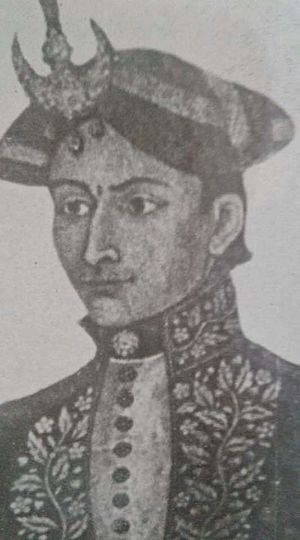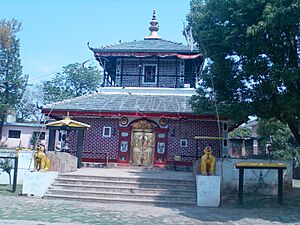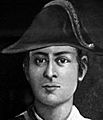Ujir Singh Thapa facts for kids
Quick facts for kids
Sri Colonel Kaji
Ujir Singh Thapa
|
|
|---|---|
| श्री कर्णेल काजी उजिरसिंह थापा |
|

Colonel Ujir Singh Thapa Kaji wearing noble attire at young age
|
|
| Governor of Palpa | |
| In office 8th Mangshir, 1871 B.S. – circa 1825 |
|
| Preceded by | Amar Singh Thapa |
| Personal details | |
| Born | Chaitra, 1852 Bikram Samwat (1796 A.D.) |
| Died | 20th Mangshir, 1881 B.S. (aged 29) Aryaghat, Kathmandu |
| Relations | Bhimsen Thapa (uncle) Ranajit Pande (maternal grandfather) Queen Tripurasundari of Nepal (sister) Mathabarsingh Thapa (brother) Jung Bahadur Rana (nephew) |
| Parents |
|
| Signature |  |
| Military service | |
| Allegiance | |
| Rank | Colonel (Nepali convention) |
| Battles/wars | Anglo-Nepalese war |
Ujir Singh Thapa (also known as Uzir Singh Thapa) was an important Nepali leader and army officer. He was the son of Kaji Nain Singh Thapa and the nephew of Bhimsen Thapa, who was a very powerful leader at the time. Ujir Singh Thapa also had a younger brother named Mathabar Singh Thapa.
When he was a teenager, Ujir Singh Thapa became a military commander. He led soldiers in the Palpa-Butwal area during the Anglo-Nepalese War. In 1814 AD, he became the Governor (Bada Hakim) of the Palpa region. He also commanded the army there. He took over this important role from his grandfather, Amar Singh Thapa, who had passed away that year.
Contents
Early Life and Family Connections
- Further information: Thapa dynasty
Ujir Singh Thapa was born in 1796 AD. His father was Kaji Nain Singh Thapa. His grandfather was Sanu Sardar Amar Singh Thapa.
When he was 19 years old, Ujir Singh Thapa traveled from Kathmandu to Palpa. This journey took 20 days. On December 8, 1814, he officially took charge as the Governor of the Palpa Province.
Military Achievements and Leadership
Ujir Singh Thapa held the rank of Colonel in the Nepali Army. This was a very high position. He even had his own special black seal, which was used on official letters.
He is famous for a great victory against the British army. This happened at the Battle of Jit Gadhi during the Anglo-Nepalese War (1814–1816). Ujir Singh Thapa was the main military commander in the Palpa-Butwal area during this war.
Defending Jit Gadhi
Ujir Singh Thapa placed 1200 soldiers to defend key forts like Jit Gadhi, Nuwakot Gadhi, and Kathe Gadhi. He was known for being smart about using his soldiers, supplies, and the natural mountain landscape. He was very good at mountain warfare.
A British officer, Henry Thoby Prinsep, wrote about Jit Gadhi. He said that the Nepali soldiers, led by Colonel Ujir Singh, had built a strong fort called Jeetgurh. The British planned to attack it.
Preparing for Battle
Before the war started, Ujir Singh Thapa made sure his region was ready. He built roads, bridges, and strong forts in the Butwal-Palpa area.
The British army began their attack on Jit Gadhi in January 1814. As they tried to cross the Tinau River to reach the fort, Ujir Singh's soldiers opened fire. This forced the British to retreat. Later, at Tansen Bazaar, the British again had to fall back. They lost many soldiers, while the Nepali forces lost fewer.
Sindoor Jatra Festival
Before fighting the British in the 1814-1816 war, Ujir Singh Thapa prayed for victory. He visited the Rana Ujeshwori Bhagwati temple in Tansen Bazaar. He promised to build a new temple and start a special festival if the Nepali army won.
After the Nepali forces won, he kept his promise. He started building a three-story temple in 1815 AD. It was finished in 1819 AD. When the temple was complete, he donated gold equal to his own height. This gold was used for the temple's top, called the Gajur. He also had a silver statue of the goddess Bhagwati made. Its 18 arms were crafted from eight different metals (Ashtadhatu).
In 1820 AD, he started the Sindoor Jatra festival. This procession, which includes spreading vermillion powder, is still celebrated today. It remembers the great victory of the Nepali forces.
Military Rules
In 1822 AD, Ujir Singh Thapa created six important rules. These rules helped manage both the government and the army in his region.
Remembering Ujir Singh Thapa
Ujir Singh Thapa is still remembered as a hero in Nepal.
On April 7, 2017, a statue of Ujir Singh Thapa was revealed in Tansen, Palpa. The Chief of Army Staff, Rajendra Chhetri, was there for the event. The statue was built by local groups and the Nepali Army.
There are also plans to put another statue of Ujir Singh Thapa at the Jitgadhi Killa fort. This fort is located by the Tinau River in Butwal. The fort was named Jeetgadh (meaning "Victory Fort") because of the Nepali victory there during the Anglo-Nepalese War. Local leaders want to make Jeetgadh a symbol of national pride and a landmark for Butwal.
Images for kids
-
Colonel Ujir Simha Thapa and Captain Balbhadra Kunwar both fought in Anglo-Nepalese War







